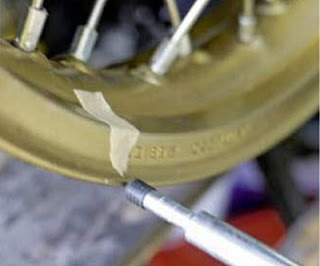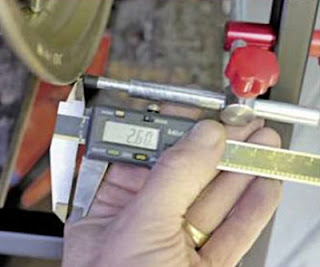Early Suzuki GS750s and 1000s, Honda CBs and a handful of others stuck with the traditional wire-spoke wheel, while off-road bikes continue to feature them to this day. Motorcycle engineers still debate whether a bike on wire wheels hangs from the top spokes or rests on the lower ones. But whether suspended or supported the simple fact is that spoked wheels can – and do – go out of true.
Most of us have filed the prospect of truing wire-spoked wheels alongside such notions a hand-striping a tank or winning a MotoGP race. However, with a little patience a spoked wheel can be corrected by the DIY enthusiast …
Tools for the job : Wheel stand. Spoke wrench. Straight edge. Vernier caliper
Cost : You can get a decent spoke wrench for around a tenner. This Sealey Tools one has interchangeable ends for different size nipples. A wheel stand costs from £50 to £100. We’ll assume you have a vernier caliper and a straight edge.
 |
| Before we get into the business of truing the wheel, check the bearings. This is done for two reasons. Firstly, you will never true a wheel that’s wobbling on its bearings. Secondly, a wheel may appear to be out of true, when in fact the problem is the bearings themselves. |
 |
| Make sure that all the nipples are correctly engaged in their seats, and that the spokes aren’t protruding through the nipples. It’s not an issue with these cleverly designed Central Wheel replacement spokes but others may need filing flush when you’re done. |
 |
| Check for loose spokes with a gentle nudge on the wrench. Start with the first spoke next to the valve and then every fourth spoke, then the second from the valve and every fourth from that. Continue until they’re all checked. It means you alternately work on spokes pulling from opposite sides. |
 |
| Your manual should tell you the correct offset for your wheel – that is the axial distance from the hub to the rim. On the TDR it’s 31mm from the sprocket carrier side bearing boss to the edge of the rim and on the other side, 41mm from the brake disc face to the edge of the rim. |
 |
| Use some bits of masking tape or similar to mark a point where the offset is correct, or closest to being right. Mark more than one point if most of the rim is about where it should be. The wheel stand’s pointer provides a visual aid as to how true the rim is when you spin it. |
 |
| Again, reference to your manual will tell you how much axial run-out (side-toside) is acceptable. The Yamaha manual says the TDR should be no more than 2mm out, which is also the generally accepted figure for off-road wheels. Road wheels are usually a little less at 1mm to 1.5mm. |
 |
| In the previous step the vernier showed the wheel to be 2.6mm out at its furthest point. See the three spokes adjacent to my fingers that point out to the right? Next, I’m going to be tightening those and loosening the two in between that go off to the left. |
 |
| Take the spoke wrench and apply it to the spokes next to the problem areas. For us amateurs, small amounts yield better results. An eighth of a turn at a time is about right. Persevere until each wobble comes out and the rim is within 2mm of the pointer all round. |
 |
With the side-to-side wobble sorted, you can now do the radial run out. Reposition the pointer to the outside edge of the rim. Again you’re looking for a couple of millimetres or less. Some might prefer a dial test gauge to a pointer, but meeting its precision will drive you mad. |
 |
| To correct a high spot, the half-dozen or so spokes at its centre should all be tightened, while an equivalent number directly opposite on the circumference should be loosened by an equivalent amount. This has the effect of moving the whole rim across the wheel’s centre. |
 |
| Once everything looks right radially in relation to the pointer when the wheel is spun, re-check the side-to-side movement against the pointer. Finally, check the offset at several points around the rim on both sides. Note that old rims might have the odd little buckle you’ll never tweak out. |
 |
| Take the spoke wrench and gently tap the spokes all the way around the wheels on both sides. All should ring nicely and shouldn’t sound dead. Check any that do. A slight difference in pitch is OK between spokes but you shouldn’t be able to play a tune on a wire-spoked wheel. |












